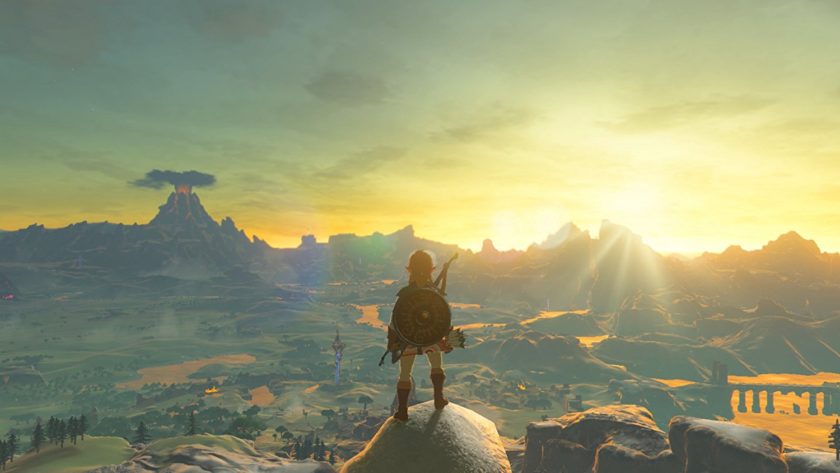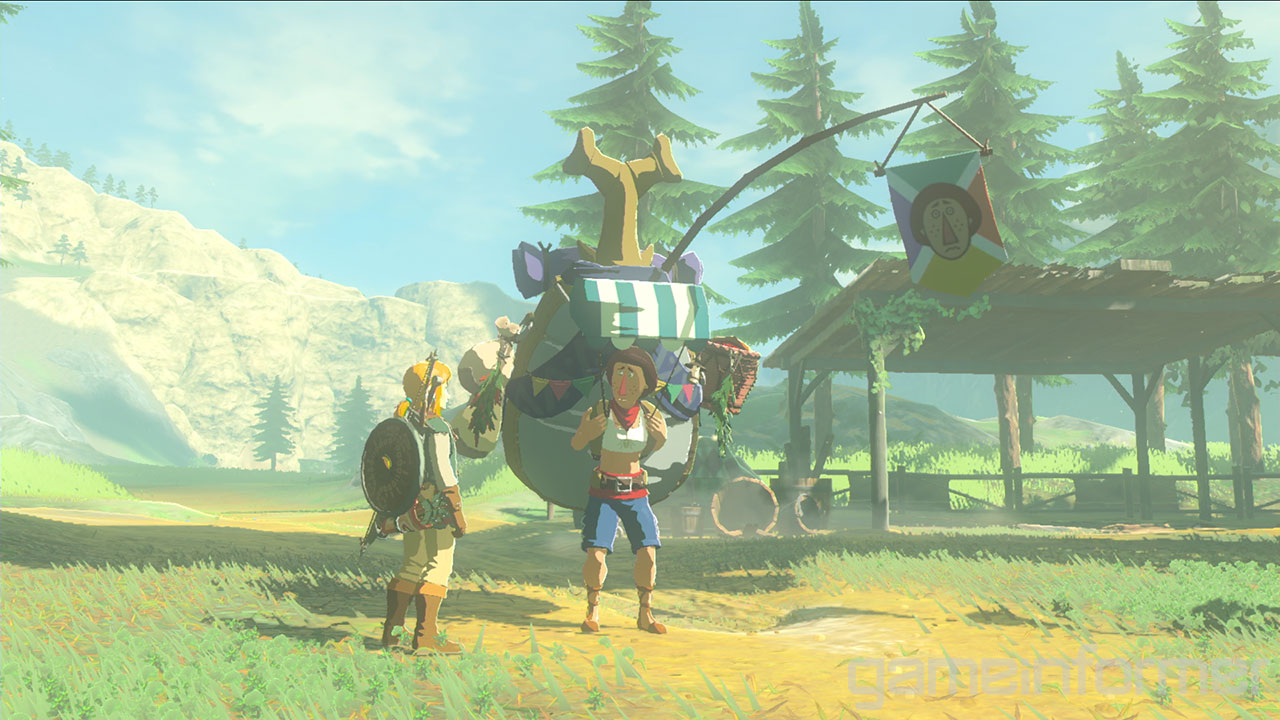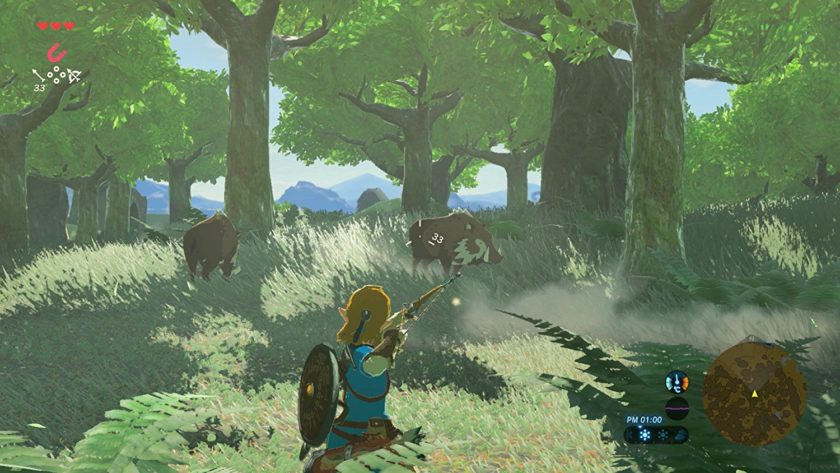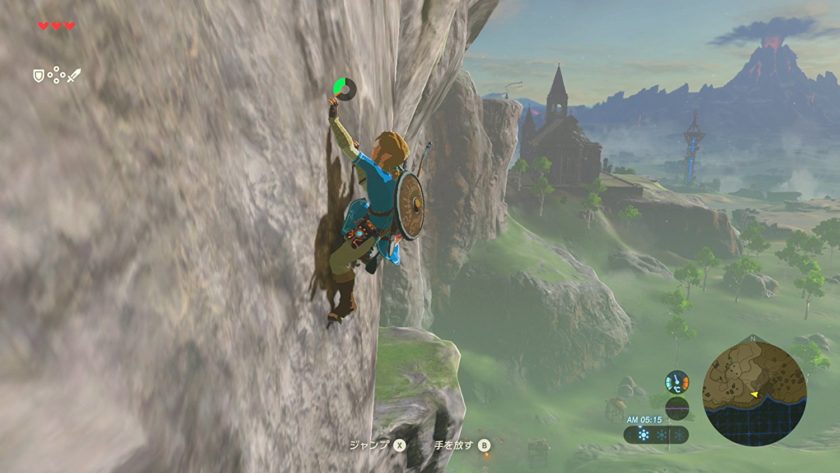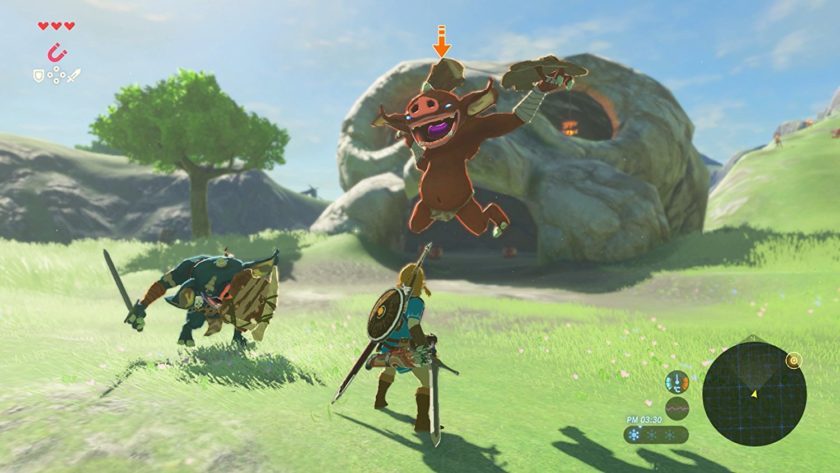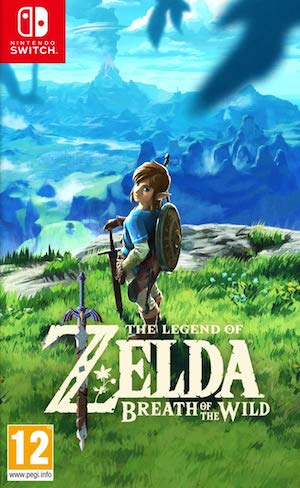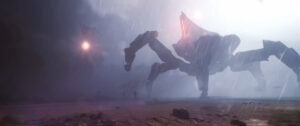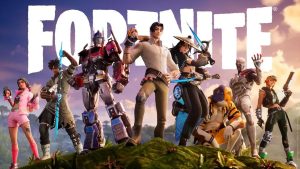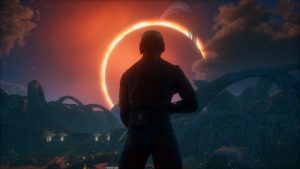
It begins like many other Zelda games have – with an awakening. The Hero of Time, the savior of Hyrule, the slayer of Ganon rises once more but this isn’t the same Link. And this isn’t the same Hyrule. After rudimentary instructions and getting ready to leave, Princess Zelda tells us “You are the light – our light – that must shine on Hyrule again.” The blinding entrance light fades. Our hero climbs out. Birds are singing and insects chirping outside. An epic score begins but quickly mellows out and Link takes survey of the massive landscape that is Hyrule. It’s not long before an old man and a familiar structure in the distance catches his eye.
This sequence here encapsulates so much about The Legend of Zelda: Breath of the Wild. The world is familiar but expansive and mysterious. Link has nothing – no weapons, no shield and no real armor – to start with. He scrounges up a branch or two, probably finds an axe and starts collecting apples which can restore his health. Diving causes Link to drown if he doesn’t have enough stamina.
He has a stamina meter now, by the way, which influences how much he can sprint and climb. Climb? Link can climb now and go just about anywhere? Yes, but actually no – not without some craftiness that is. There are also enemies and they can wallop our hero pretty good if he isn’t paying attention. Link is tasked with exploring four Shrines and obtaining the powers within before returning to the old man. But first, climb that tower over there. On the difficulty scale, the first one’s free but they get tougher later.
What in the world is going on? This is probably the best time to mention that Link has lost his memories.
It’s not immediately obvious but given that massive castle in the distance has evil energy swirling around it, you get the impression that the world is screwed. Powerful Guardians which almost kill you with their eye-beams lay dormant, to say nothing of those walking around. Eventually, Link learns that Hyrule was gearing up to battle the Calamity known as Ganon. It was foretold – we had Divine Beasts and Guardians lined up along with Princess Zelda’s powers.
Unfortunately, Ganon already saw through this and took control of the Beasts and Guardians beforehand, laying waste to Hyrule in the process. Link was injured while trying to protect the princess and placed into a recuperative coma. Meanwhile, Zelda is left on her own to fight Ganon. Fast forward to the current day. The old man from the beginning is revealed to be the spirit of the King of Hyrule and after giving you a glider, he tasks you with saving his daughter who’s still fighting to keep the Calamity contained in Hyrule Castle.
The mission is received: “Defeat Ganon”. Glide out of the plateau and the large plateau expands into a giant world. You can go anywhere and do anything. You can pick up a broom and hoof it to Hyrule Castle to fight Ganon (which will mostly likely result in your imminent death). You can take to Gerudo Desert, sweltering in the heat by day while freezing to death by night. You might want to even follow the assigned quests and seek out Impa for more guidance.
Shrine hopping might be good for further upgrades but maybe you want to find a good horse first. What’s that giant dragon flying around in the sky? How do you get better armor? There are many questions to be had even if you eventually meet Impa and set about trying to free the Divine Beasts.
There were also many questions for how you, the player, wanted to tackle each encounter. Take a random Bokoblin camp. You could throw a bomb and detonate it, scattering foes before they pick up any weapons. You could pick up a metal crate with Magnesis and swing it around, smacking any enemies caught in its path. There were a number of possibilities and while not every method was the smartest – or had the best success rate – it was fun to experiment. It was even more fun when they worked.
The Legend of Zelda: Breath of the Wild was never conceived as a successor to the traditional series formula. From the outset, it was meant to defy expectations, rethinking exploration and melding the various game areas, previously segregated into screens, into one cohesive whole. An earlier form of this style of exploration could be seen in The Legend of Zelda: A Link Between Two Worlds for the 3DS. You could attempt the game’s dungeons in any order. Link also merged with walls, transforming into a mural that could bypass obstacles and reach new areas – an energy gauge represented the time limit this was possible. Then there were Rented and Purchased Items – dying caused the Rented Items to return to the vendor. But this allowed for even more freedom to play the game how you wished.
With a rough blueprint in mind, work began on the game’s physics engine. Series producer Eiji Aonuma noted that it “underpins everything in the world” and it shows. Metal conducts lightning so during thunderstorms, Link becomes a walking conducting rod, susceptible to lightning strikes unless you unequip any metal armor and weapons. The ambient temperate of a volcano will melt through any equipped wooden items. Objects store momentum, allowing you to cast Stasis, strike them numerous times and go flying once the ability has included. You could even Shield Hop to get to higher areas, which has created a number of Shrine speed-running tactics.
While initially in development for the Wii U, Nintendo EPD would focus on the Switch, resulting in The Legend of Zelda: Breath of the Wild becoming a launch title for the platform. Monolith Productions, known for its work on Xenoblade Chronicles, was tapped to create the various landscapes and environments.
The design focused on the Triangle Rule, as per Capcom’s Matt Walker who translated a talk from the development team at Nintendo during CEDEC in 2017. “Using triangles carries out 2 objectives. [It] gives players a choice as to whether to go straight over the triangle, or around, and it obscures the player’s view, so designers can utilize them to surprise players [and] make them wonder what they’ll find on the other side.”
Rectangles are also used to further this goal, defining the environment and directing the player towards certain objectives like towers. The world is non-uniform in how it doles out different objectives and points of interest. So you won’t necessarily run into the same things that other players do, even if taking roughly the same path to an objective.
It’s also how you can ignore certain quests and side-quests entirely to just explore and make your own experiences. This is further reinforced by the lack of question marks, points of interest, way-points and the like. Towers serve to unlock a region on your map and act as a fast travel point but they’re actually vantage points. You use them to survey your immediate surroundings like shrines, slowly mapping out the region yourself and taking the time to go off the beaten path.
The game is set up to be intimidating and can seem overly punishing at first. Some foes in areas can hit you for massive amounts of damage. The weather also plays a big part in Link’s health as he can suffer from excess heat or cold. In the same vein, he’s also somewhat limited by his stamina – you can climb just about any rock face in the game but need to be careful about it, picking and choosing spots to climb or recover stamina rather than brute-forcing it. This actually turns into a neat mini-game as you mentally chart out a path up a cliff. The right armor can make climbing a heck of a lot easier.
However, you learn very quickly that the best armor isn’t always needed to negate the weather, buff your defenses or traverse the world. When it doubt, just eat some food. A number of ingredients dot the landscape from apples and red peppers to crabs and herbs. You can combine up to five different ingredients together to create a dish and the effects range from increased defense and attack to cold and heat resistance. Some grant an additional wheel of stamina while others increase your movement speed. Resistance to elemental attacks like fire, ice and thunder is also possible. And if you don’t have any food ingredients in hand, use monster parts and insects to craft different elixirs. Some have incredibly potent effects like fully increasing your health and providing temporary hearts for additional vitality.
By exploiting the cooking mechanic, one can travel the world with relatively reckless abandon. Only one buff can be active at a time so you need to decide between buffing your defense in a fight versus surviving the weather. Finding ingredients involves exploring, killing monsters, spending rupees at vendors and so on, further encouraging exploration. You’ll also need a campfire to cook the food which can either mean resting at a stable or attacking an enemy camp. This further feeds into the game’s combat loop and weapon durability.
Right off the bat, it feels like weapons are too fragile in Breath of the Wild but that’s yet another motivator to exploring the world. You’re meant to constantly replace your weapons, balancing some of the more hard-hitting and rarer tools like the Thunderblade with more common weapons like the Soldier’s Broadsword.
On the one hand, you shouldn’t get too attached to a particular weapon since it can break but on the other hand, specific weapons belong to specific regions and areas so it’s not hard to seek out a particular item. There are weapons like the Master Sword and Hylian Shield which can’t break, providing some means of stability in this chaotic world. But the game wants you constantly out there, mixing things up rather than staying safe with a selection of the most powerful tools. Weapons could use a bit more durability as a whole but it is what it is.
Though the combat doesn’t come across as anything remarkably complicated at first, it still has a welcome amount of depth. Managing your runes, switching between two-handed swords and spears as the situation calls for it, exploiting the environment to take out groups of foes and even tossing weapons set to break for more damage are a few tactics you can utilize. Perfectly evading attacks will trigger a Flurry Rush where you can get in multiple hits on a foe while parrying at the right time can lead to openings. The latter is also a trump card against the Guardians since it can deflect their lasers right back at them.
Despite being on relatively less powerful hardware, The Legend of Zelda: Breath of the Wild looks gorgeous, employing an animated aesthetic without going fully into cel-shading. Technically, the game implements physically based rendering, dynamic wind simulation, screen space ambient occlusion and global illumination, some implemented in clever ways without overly taxing the system. The result is a stunning title with an impressive sense of scale and solid frame rate, especially when playing on the go. The game’s music is understated, blending into the atmospheric ambiance and only really emerging during battles and boss fights.
There are plenty of reasons one may dislike The Legend of Zelda: Breath of the Wild. Its story isn’t as guided as past titles, opting for a much more free-form experience (there is plenty of interesting lore and characters to uncover though). The Divine Beasts serve as the de facto dungeons, meaning there’s only real four compared to past games, and the Shrines serve as mini-challenges rather than replacements (with some repeating challenges like defeating an enemy).
Overall though, Breath of the Wild provides a unique open world experience, one that blends the best of the genre with The Legend of Zelda‘s tropes. With the sequel on the horizon, possibly taking place before the Calamity, it’s good to see Nintendo investing in this particular iteration of the legend. There’s an indelible sense of wonder in getting lost in Hyrule, uncovering new secrets and wonders even after dozens of hours of play, and slowly but surely rearmed Link for the battle ahead. And it is awesome.








